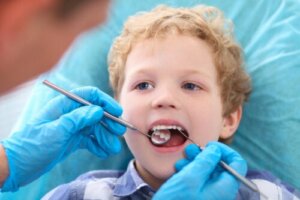My Child Doesn't Eat Sweets and Has Cavities: Why?


Written and verified by the dentist Vanesa Evangelina Buffa
Many parents wonder why their child who doesn’t eat sweets still has cavities. However, although sugar consumption is one of the factors that favor the appearance of the disease, it’s not the only one. Keep reading to find out the reasons and how to avoid them.
Cavities are a multifactorial disease that causes the loss of the hard tissues of the teeth. Tooth demineralization is caused by the action of acids produced by bacteria in the mouth fermenting sugars in the diet. Learn more below.
Why do cavities occur in children?
The appearance of cavities in children’s mouths may be due to a combination of several situations. There are four main factors involved in the development of the disease. Let’s take a closer look at each of these situations that, when added together, can lead to the appearance of cavities in your child.
1. Bacteria
Bacteria are one of the conditioning factors for the appearance of cavities in children’s mouths. However, for these germs to be present in the oral environment, they must first colonize it.
Children often acquire bacteria from their parents or caregivers. Some common but harmful practices, such as blowing or tasting baby food, sharing utensils, wiping pacifiers with saliva, or kissing in the mouth, promote early infection. In addition, if either parent has active cavities, the risk of germ transmission is greater. Therefore, to take care of your children’s oral health, it’s important that adults also keep their mouths healthy.
One of the reasons why your child can get cavities is the neglect of oral hygiene. Oral hygiene should start before teeth appear. Therefore, the baby’s gums should be cleaned with a wet gauze or with a silicone finger brush. Then, when the first tooth appears, you should start using a toothbrush.

2. Diet
It’s not only sweets that are responsible for tooth decay. Bacteria in the mouth metabolize fermentable carbohydrates, so any type of sugar can cause the disease. Today, most packaged products contain hidden sugars that serve as a substrate for oral germs.
For example, cookies, juices, packaged sauces, yogurts, pastries, and potato chips contain sugars that we tend to overlook. Even bread and pasta are carbohydrates that bacteria metabolize. On the other hand, hard foods, such as apples or carrots, help to sweep and clean the teeth.
The frequency of food intake is also important. In this regard, it’s important to avoid snacking constantly throughout the day and to respect meal times. Finally, with regard to hydration, the best option is always to give children natural water, as carbonated beverages, sports drinks, and fruit juices contain sugar and favor the acidity of the oral environment.
3. Host conditions
Not all children have the same susceptibility to developing cavities but there are certain individual factors that increase the risk of the disease:
- Poorly resistant or hypoplastic enamel.
- Acidic oral pH: Some children have a lower salivary pH and this facilitates the loss of minerals from the teeth.
- Dental anatomy: Some children have teeth with grooves or pits that are very deep and difficult to clean. In these anatomical accidents, food debris and bacteria tend to accumulate.
- Saliva: Some children, due to biological conditions, systemic diseases, or the use of medications, produce less saliva or a very thick fluid. This prevents its protective and cleansing action.
- Genetic predisposition.

4. Time
For bacteria to metabolize dietary sugars and produce tooth-destroying acids, they need some time. Tooth decay doesn’t happen from one moment to the next, but is a process. So, the more time that passes between brushings, the greater the risk of developing the disease.
It’s key to avoid cavities in your child who doesn’t eat sweets
If your child is a child who doesn’t eat sweets, they may develop cavities just the same. As you’ve seen, there are several factors that can favor the onset of the disease. Avoiding sweets is a big step in prevention, but it’s not the only one. In addition, you should take care of the rest of your diet, reduce ultra-processed foods, watch the consistencies, and control snacking. At the same time, you should take care of your child’s oral hygiene to remove bacterial plaque. Finally, it’s important to visit a pediatric dentist before your child’s first birthday and then every six months after that. With perseverance and the support of the professional, you’ll be able to keep your child’s mouth free of cavities.
Many parents wonder why their child who doesn’t eat sweets still has cavities. However, although sugar consumption is one of the factors that favor the appearance of the disease, it’s not the only one. Keep reading to find out the reasons and how to avoid them.
Cavities are a multifactorial disease that causes the loss of the hard tissues of the teeth. Tooth demineralization is caused by the action of acids produced by bacteria in the mouth fermenting sugars in the diet. Learn more below.
Why do cavities occur in children?
The appearance of cavities in children’s mouths may be due to a combination of several situations. There are four main factors involved in the development of the disease. Let’s take a closer look at each of these situations that, when added together, can lead to the appearance of cavities in your child.
1. Bacteria
Bacteria are one of the conditioning factors for the appearance of cavities in children’s mouths. However, for these germs to be present in the oral environment, they must first colonize it.
Children often acquire bacteria from their parents or caregivers. Some common but harmful practices, such as blowing or tasting baby food, sharing utensils, wiping pacifiers with saliva, or kissing in the mouth, promote early infection. In addition, if either parent has active cavities, the risk of germ transmission is greater. Therefore, to take care of your children’s oral health, it’s important that adults also keep their mouths healthy.
One of the reasons why your child can get cavities is the neglect of oral hygiene. Oral hygiene should start before teeth appear. Therefore, the baby’s gums should be cleaned with a wet gauze or with a silicone finger brush. Then, when the first tooth appears, you should start using a toothbrush.

2. Diet
It’s not only sweets that are responsible for tooth decay. Bacteria in the mouth metabolize fermentable carbohydrates, so any type of sugar can cause the disease. Today, most packaged products contain hidden sugars that serve as a substrate for oral germs.
For example, cookies, juices, packaged sauces, yogurts, pastries, and potato chips contain sugars that we tend to overlook. Even bread and pasta are carbohydrates that bacteria metabolize. On the other hand, hard foods, such as apples or carrots, help to sweep and clean the teeth.
The frequency of food intake is also important. In this regard, it’s important to avoid snacking constantly throughout the day and to respect meal times. Finally, with regard to hydration, the best option is always to give children natural water, as carbonated beverages, sports drinks, and fruit juices contain sugar and favor the acidity of the oral environment.
3. Host conditions
Not all children have the same susceptibility to developing cavities but there are certain individual factors that increase the risk of the disease:
- Poorly resistant or hypoplastic enamel.
- Acidic oral pH: Some children have a lower salivary pH and this facilitates the loss of minerals from the teeth.
- Dental anatomy: Some children have teeth with grooves or pits that are very deep and difficult to clean. In these anatomical accidents, food debris and bacteria tend to accumulate.
- Saliva: Some children, due to biological conditions, systemic diseases, or the use of medications, produce less saliva or a very thick fluid. This prevents its protective and cleansing action.
- Genetic predisposition.

4. Time
For bacteria to metabolize dietary sugars and produce tooth-destroying acids, they need some time. Tooth decay doesn’t happen from one moment to the next, but is a process. So, the more time that passes between brushings, the greater the risk of developing the disease.
It’s key to avoid cavities in your child who doesn’t eat sweets
If your child is a child who doesn’t eat sweets, they may develop cavities just the same. As you’ve seen, there are several factors that can favor the onset of the disease. Avoiding sweets is a big step in prevention, but it’s not the only one. In addition, you should take care of the rest of your diet, reduce ultra-processed foods, watch the consistencies, and control snacking. At the same time, you should take care of your child’s oral hygiene to remove bacterial plaque. Finally, it’s important to visit a pediatric dentist before your child’s first birthday and then every six months after that. With perseverance and the support of the professional, you’ll be able to keep your child’s mouth free of cavities.
All cited sources were thoroughly reviewed by our team to ensure their quality, reliability, currency, and validity. The bibliography of this article was considered reliable and of academic or scientific accuracy.
- Aulestia Jácome, A. N. (2022). Factores de riesgo de infectividad bucal en pacientes pediátricos. Revisión de la literatura.
- Amaral, T. R., Falcón, D. I. H., Unzaga, A. L., & Cortés, P. M. (2018). Bioquímica de la caries. Revista mexicana de estomatología, 5(1), 6-7.
- Suarez, M. R. G. (2019). La caries dental en relación con el pH salival, dieta e higiene dental. Orbis Tertius-UPAL, 3(5), 73-82.
- CORREA, Y. E. M., ARIAS, C. M. R., PICO, B. A. V., & OSEOINTEGRACION, P. D. P. Y. RELACIÓN ENTRE LA AMELOGENINA Y PREDISPOSICIÓN GENETICA A LA CARIES DENTAL: MONOGRAFÍA.
- Campusano Villamar, Y. A. (2022). Factores genéticos asociados al desarrollo de caries dental (Bachelor’s thesis, Universidad de Guayaquil. Facultad Piloto de Odontología).
- Contreras, C. M., D’Aquino, E. H., & Muñoz, P. (2022, October). Relación entre consumo de azúcar y caries temprana de la infancia en preescolares. Revisión sistemática. In XXI Congreso Latinoamericano de Odontopediatría (Vol. 12, No. Suplemento).
- Zambrano Hidalgo, M. J. (2021). Caries de la infancia temprana: prevención y tratamientos: Revisión sistemática.
This text is provided for informational purposes only and does not replace consultation with a professional. If in doubt, consult your specialist.








